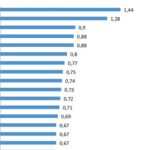The Cuban embargo, lasting over six decades, stands as the longest-standing sanctions regime imposed by the United States. While seemingly disparate, comparing it to recent sanctions against China offers valuable insights into the complexities of sanctions as a foreign policy tool. This analysis delves into the historical context, objectives, and effectiveness of both scenarios, exploring key differences and similarities.
Historical Context and Objectives: Cuba vs. China
The Cuban embargo, initiated in 1960, stemmed from the Cold War and aimed to isolate Cuba’s communist regime, economically and diplomatically, hoping to incite regime change. The sanctions targeted nearly all U.S.-Cuba trade and financial transactions.
Conversely, sanctions against China are more recent and multifaceted. Driven by concerns over human rights abuses in Xinjiang, trade practices, technological competition, and geopolitical tensions, these sanctions are narrower in scope, focusing on specific individuals, entities, and sectors like technology and defense. The primary objective is not regime change but behavioral modification, seeking to deter specific actions and encourage adherence to international norms.
Caption: Then U.S. President Barack Obama with Cuban President Raul Castro in Havana, March 2016.
Effectiveness and Impact: Divergent Outcomes
The Cuban embargo’s impact on Cuba’s economy has been substantial, though its effectiveness in achieving regime change is debatable. Critics argue that the embargo has primarily harmed the Cuban people while strengthening the regime’s grip on power.
Sanctions against China, being more targeted and recent, present a different picture. Their economic impact is less pronounced due to China’s global economic integration and diversified trade relationships. While the sanctions may create some economic pressure and hinder specific sectors, their long-term effectiveness in altering China’s behavior remains uncertain.
Caption: President Donald J. Trump meets with China’s President Xi Jinping at the Mar-a-Lago estate in Palm Beach, Florida, April 7, 2017
Key Differences and Similarities
A crucial difference lies in the international context. The Cuban embargo enjoyed limited international support, while sanctions against China receive backing from some Western allies, albeit with varying degrees of enthusiasm. This difference in international support significantly impacts the effectiveness of the sanctions.
Another distinction is the targeted nature of sanctions. The Cuban embargo was a blanket ban, while sanctions against China are more selective, aiming to minimize harm to the broader population and global economy.
Despite these differences, both cases highlight the limitations of sanctions as a standalone foreign policy tool. Sanctions rarely achieve their objectives without complementary diplomatic and other policy measures. Both the Cuban embargo and sanctions against China demonstrate the complex interplay of political, economic, and geopolitical factors in shaping the outcomes of sanctions regimes.
Caption: Cubans protest in Havana, July 11, 2021
Conclusion: Lessons Learned
Comparing the Cuban embargo and sanctions against China underscores the need for a nuanced understanding of sanctions. Their effectiveness hinges on factors like international support, the target country’s economic resilience, and the specific objectives of the sanctions regime. While sanctions can exert pressure and signal disapproval, their ability to induce fundamental changes in a target country’s behavior is often limited and requires a broader strategic approach. The historical trajectory of the Cuban embargo serves as a cautionary tale, highlighting the potential for unintended consequences and the importance of continually reassessing the effectiveness and humanitarian impact of sanctions. Analyzing these two cases emphasizes the need for clear objectives, targeted measures, and a comprehensive foreign policy strategy that integrates sanctions with other diplomatic and economic tools.
